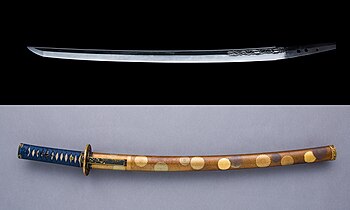
Back واكيزاشي Arabic Вакідзасі Byelorussian Вакідзасі BE-X-OLD Уакизаши Bulgarian Wakizashi BS Wakizashi Catalan واکیزاشی CKB Wakizaši Czech Wakizashi Danish Wakizashi German
| Wakizashi (脇差) | |
|---|---|
 Blade and mounting for a wakizashi. The blade was made by Soshu Fusamune. Blade, late 15th–early 16th century; mounting, 18th century. There were many different makers for the katana. The Metropolitan Museum of Art | |
| Type | Sword |
| Place of origin | Japan |
| Production history | |
| Produced | Muromachi period (1336–1573) to present |
| Specifications | |
| Blade length | approx. 30–60 cm (12–24 in) |
| Blade type | Curved, single-edged |
| Scabbard/sheath | Lacquered wood |
The wakizashi (Japanese: 脇差, 'side inserted sword'[1]) is one of the traditionally made Japanese swords (nihontō)[2][3] worn by the samurai in feudal Japan. Its name refers to the practice of wearing it inserted through one's obi or sash at one's side, whereas the larger tachi sword was worn slung from a cord.
- ^ Ogyû Sorai's Discourse on government (Seidan): an annotated translation, Sorai Ogyū, Otto Harrassowitz Verlag, 1999 p. 105
- ^ The Development of Controversies: From the Early Modern Period to Online Discussion Forums, Volume 91 of Linguistic Insights. Studies in Language and Communication, Author Manouchehr Moshtagh Khorasani, Publisher Peter Lang, 2008, ISBN 978-3-03911-711-6 p. 150
- ^ The Complete Idiot's Guide to World Mythology, Complete Idiot's Guides, Authors Evans Lansing Smith, Nathan Robert Brown, Publisher Penguin, 2008, ISBN 978-1-59257-764-4 p. 144